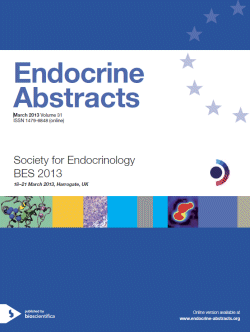Searchable abstracts of presentations at key conferences in endocrinology
Symposia
Irn bru, to drink or not to drink: endocrinology and iron
ea0031s1.1 | Irn bru, to drink or not to drink: endocrinology and iron | SFEBES2013
Iron homeostasis: who are the major players?
Iron, an essential trace element for almost all organisms, has a structural or functional role in a number of proteins and enzymes. Total body iron amounts to ~35 and 45 mg/kg of body weight in healthy adult women and men, respectively. This iron is highly conserved and daily iron losses, normally only 0.5 to 2 mg via non-specific processes, are compensated for by absorption of an equivalent amount of iron from the diet. The precise regulation of cellular iron uptake and stora...
ea0031s1.2 | Irn bru, to drink or not to drink: endocrinology and iron | SFEBES2013
The iron-regulatory hormone hepcidin
The hepatic peptide hormone hepcidin is the principal regulator of iron absorption and tissue iron distribution. Hepcidin circulates in blood plasma and acts at nanomolar concentrations by inducing degradation of its receptor, the cellular iron exporter ferroportin. Ferroportin exports iron into plasma from absorptive enterocytes, from macrophages that recycle the iron of senescent erythrocytes, and from hepatocytes that store iron. Therefore, hepcidin-mediated degradation of ...
ea0031s1.3 | Irn bru, to drink or not to drink: endocrinology and iron | SFEBES2013
The celtic disease – haemochromatosis: a disease of iron overload
Zoller Heinz , Schranz Melanie
In contrast to the conventional view of haemochromatosis as a monogenic disease with autosomal recessive inheritance, more recent evidence form genetic, epidemiological, cell biological and clinical studies, challenges this view. The concept that haemochromatosis is an endocrine disorder of mixed etiology embraces the poylgenic nature of the disease, the low penetrance and the similarities in phenotype of genetic and acquired forms of iron overload. Key to understanding haemoc...




